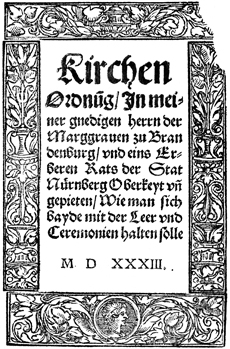Andreas Osiander facts for kids
Quick facts for kids Andreas Osiander |
|
 |
|
| Born | 19 December 1498 in Gunzenhausen, Principality of Ansbach |
|---|---|
| Died | 17 October 1552 in Königsberg, Duchy of Prussia |
| Church | Lutheran |
| Education | University of Ingolstadt (no degree) |
| Ordained | 1520 |
Andreas Osiander (born December 19, 1498 – died October 17, 1552) was an important German Lutheran thinker. He was a theologian, which means he studied religion. He also helped lead the Protestant Reformation, a big change in Christianity.
Contents
Early Life and Career
Andreas Osiander was born in Gunzenhausen, a town in Germany. He went to the University of Ingolstadt to study. In 1520, he became a priest in the city of Nuremberg.
- In 1520, he started teaching Hebrew at an Augustinian church.
- By 1522, he was working at St. Lorenz Church in Nuremberg.
- At this time, he openly said he supported Martin Luther's ideas.
Helping the Reformation
Osiander played a key role in the Protestant Reformation. This was a movement that changed how Christianity was practiced in many parts of Europe.
- In 1522, he met Albert of Prussia. Albert was a powerful leader of the Teutonic Knights.
- Osiander helped convince Albert to become a Lutheran.
- He also helped Nuremberg become a Protestant city in 1525.
- In the same year, Osiander got married.
Important Meetings
Osiander attended several important meetings during his life. These meetings shaped the future of the Reformation.
- He was at the Marburg Colloquy in 1529.
- He also attended the Diet of Augsburg in 1530.
- In 1531, he was present for the signing of the Schmalkalden articles.
Moving to Königsberg
In 1548, Osiander had to leave Nuremberg. This was because of a new law called the Augsburg Interim.
- He first moved to Breslau (now Wrocław).
- Then, in 1549, he moved to Königsberg (now Kaliningrad).
- In Königsberg, he became a professor at the new Königsberg University.
- Albert of Prussia, whom Osiander had helped, appointed him to this job.
- Osiander lived and worked in Königsberg until he died in 1552.
Osiander's Family
Andreas Osiander's family also had many theologians.
- His son, Lukas, became a theologian.
- His grandsons, Andreas and Lukas, also followed in his footsteps.
- His niece, Margarete, married Thomas Cranmer. Thomas later became a very important church leader in England.
Major Works
Andreas Osiander wrote and helped publish several important books.
Bible Edition
In 1522, Osiander published a new version of the Vulgate Bible. This was a Latin translation of the Bible.
- His edition included his own notes.
- It helped people better understand the text.
Church Order Book
In 1533, a book called Brandenburg-Nuernbergische Kirchenordnung was published. Osiander helped a lot with this book.
- It was a guide for church services and teachings.
- It was the first book to include the "Keys section" from Luther's Small Catechism.
- Many people think Osiander wrote this part.
Gospel Harmony
Osiander wrote a book called Harmoniae Evangelicae in 1537. This book tried to combine the stories from the four Gospels in the Bible.
- It showed the Greek text on one page and a Latin translation on the other.
- He added notes explaining how he put the stories together.
- Osiander believed that if two Gospel stories seemed different, it meant the event happened multiple times.
- For example, he thought Jesus healed blind men at Jericho four times.
- Other important reformers, like Luther and Calvin, did not agree with this idea.
Copernicus's Book
In 1543, Osiander helped publish a very famous book. It was De revolutionibus orbium coelestium by Copernicus. This book said that the Earth goes around the Sun.
- Osiander added a special introduction to the book.
- In this introduction, he suggested that the ideas in the book might not be true. He said they were just useful for calculations.
- Copernicus probably didn't know about this addition.
- Because Osiander didn't sign the introduction, many readers thought Copernicus himself didn't believe his own ideas were true.
Controversial Ideas
In 1550, Osiander published two papers that caused a lot of debate. They were about how people become righteous in God's eyes.
- Osiander believed that God makes people righteous by putting Christ's divine nature inside them.
- This idea was different from what Martin Luther and John Calvin taught.
- His ideas were continued by his son-in-law, Johann Funck, for a while.
- Some historians say Luther's early ideas were actually similar to Osiander's.
Theology and Beliefs
Osiander had some unique ideas about religion. He was a Christian mystic. This means he believed in a very close, spiritual connection with God.
- He thought that a Christian becomes righteous because Christ lives inside them.
- This was different from Luther's view. Luther believed God declares someone righteous because of Christ's sacrifice, not because Christ is inside them.
- Other reformers like Melanchthon and Flacius also disagreed with Osiander.
- Flacius believed God makes us righteous through Christ's work on the cross.
See Also
 In Spanish: Andreas Osiander para niños
In Spanish: Andreas Osiander para niños



